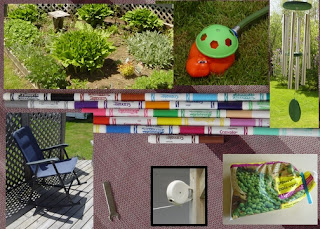
I left my serger on Cape Cod, whaaa! But, you can still sew clothes on a sewing machine without a serger and here are some photos of what I did this week; pants.
*
First off, I got a great length of jersey at Marden's for $3.50. It was just perfect for McCall's 4664, which I got for $1 at a Joanne's pattern sale. Using my measurements, I made a size 12 - which very obviously was too big (my sewing pattern size is usually 12 though as sewing pattern sizes vary greatly from ready to wear). Now, I could have easily taken in the leg width and pick out the back part of the waistband, chop a few inches off evenly from each side and then re-sewn the back waistband back on - stretching the waistband to fit. After all, it is a stretchy fabric and you can usually convice stretchy fabric into doing what you want it to do! BUT - I was thinking that these pants will probably fit one of my sister's perfectly - she is a little shorter than me so instead of doing all those alterations for a pair of pants for me - I shortened the legs for her. I will get another piece of fabric and make a different pair for me.
*
So, McCall's 4664 is very easy, has nice lines, but runs large. I really recommend this pattern! Because the fabric used is a stretch, I will cut 2 sizes smaller for my own pair. Not having my serger, I used the "lightening bolt" (stretch stitch) stitch for the seams. I pinked the seams (yes, pinking shears are sitll a useful sewing tool - pricy, but I got mine with a 50% off coupon at Joanne's). Do not finish the raw edge of a knit hem because it will create waves. I used 2 rows of stitching at the pants hem to give a nice finish. Being used to a serger, sewing the seams seemed s-l-o-w, but it really isn't that bad!
*
One more thing - keep track of the front and back pieces - mark these very clearly with chalk or your favorite method of marking - on the wrong side of the fabric - below the seams for the waist or else you will cut the markings off when you sew the seams. When attaching the waistband, insert a piece of folded ribbon (like a little loop) into the center back - that way you will know the front from back when putting them on!
*
About that lightening bolt stitch - I can manage it just fine without the fabric slipping, BUT - when I asked my husband to finish off a seam for me he got the layers a bit shifted - so if you have a walking foot for your machine - use it! And yes, my husband was a good sport to sew the seam for me - I was in the middle of another project and one of the machines for that needed a bit of babysitting from me - so he finished the seam while I did the other thing.
New Look 6307... this pattern is very high waisted. I ended up cutting off 3" from the top - I would have taken more, but that would have really distorted the side pocket. It seemed like a complete waste to use my elastic in a casing when I had just enough stretchy jersey fabric left over from making my pants to make a stretchy waistband for these pants. No-one sees the waist anyway if you wear a shirt over it. And NO - these funky vegetable print pants are not for me. I will be making these pants again - using the same stretchy waistband idea, making them a bit lower waisted, adding a tiny bit more room through the hip. I am hoping the 2nd pair will be just perfect!
*
When sewing clothes, I often use very inexpensive fabrics (but still good quality) for the 1st try. It is common to make a "muslin" version first when sewing clothes (the muslin version does not have zipper, buttons, elastic, etc. - it is just to check the basic fit). For me, I prefer to actually make the entire garmet, make my adjustments, make basic notes right on the back of the envelope and then make it again using different fabrics. Of course, this is for fairly simple items - if I were making a fitted jacket, then I would do the muslin technique so I can write all my pattern changes directly onto the muslin fabric.
*
So - there you have it - 2 pairs of pants.










